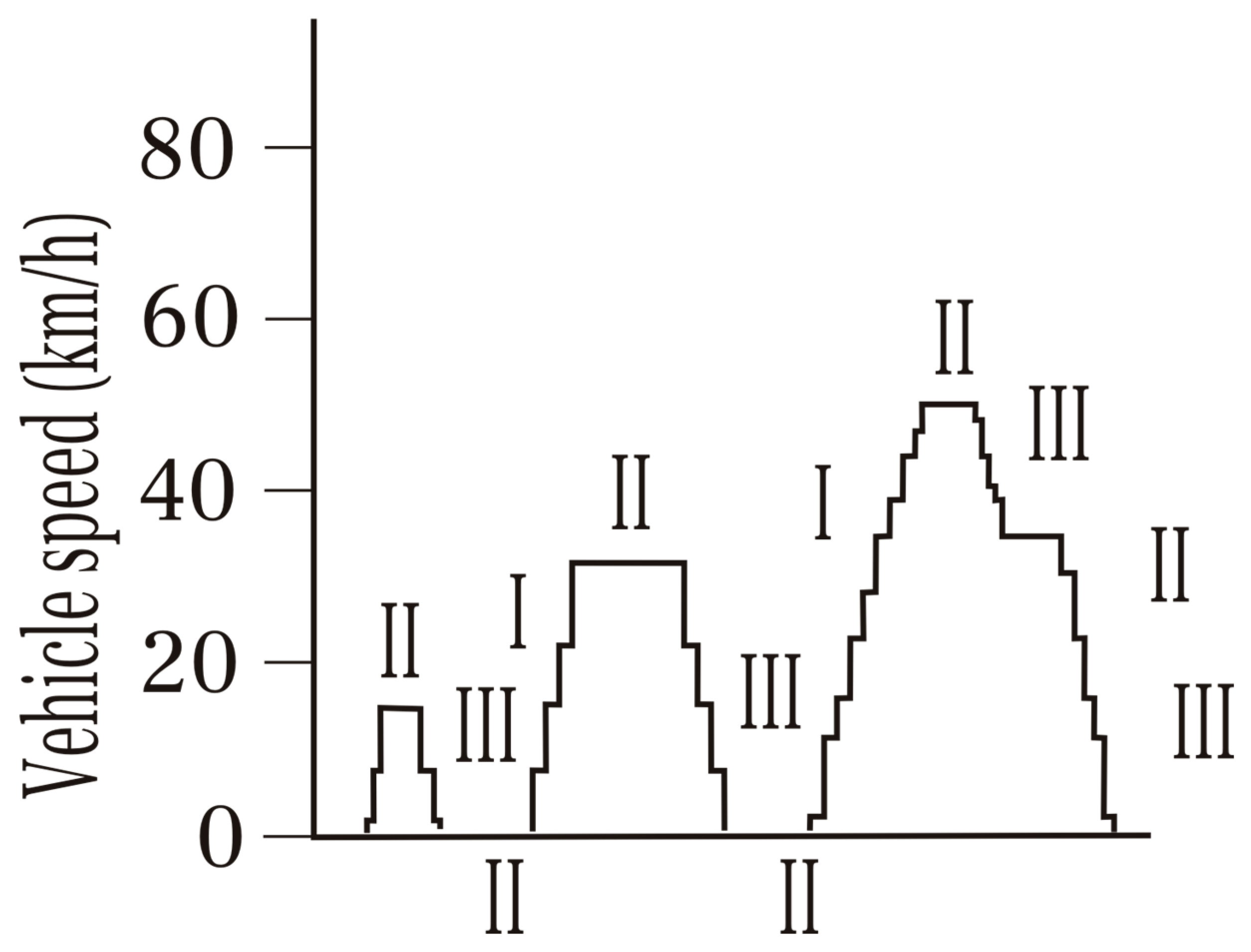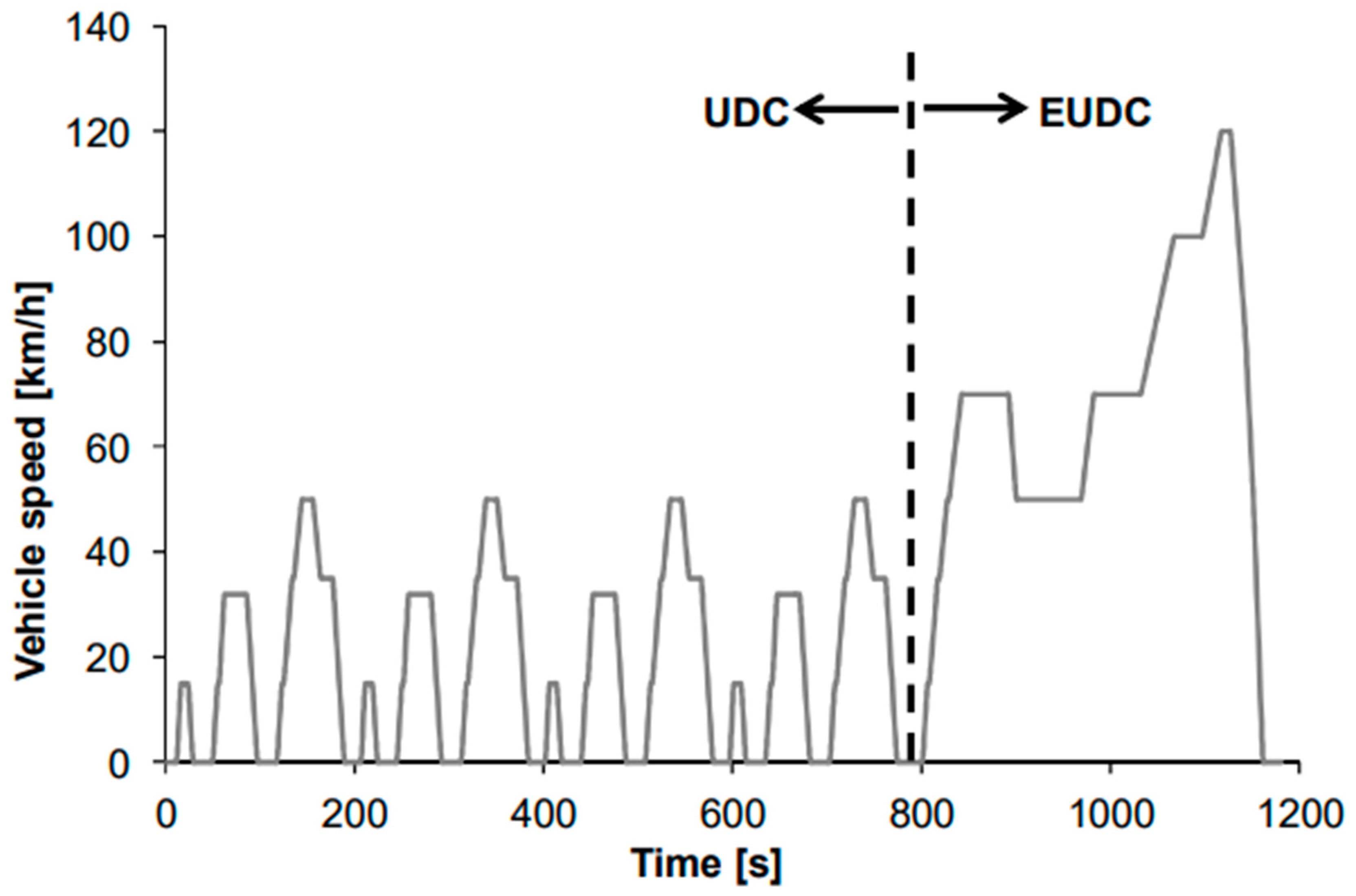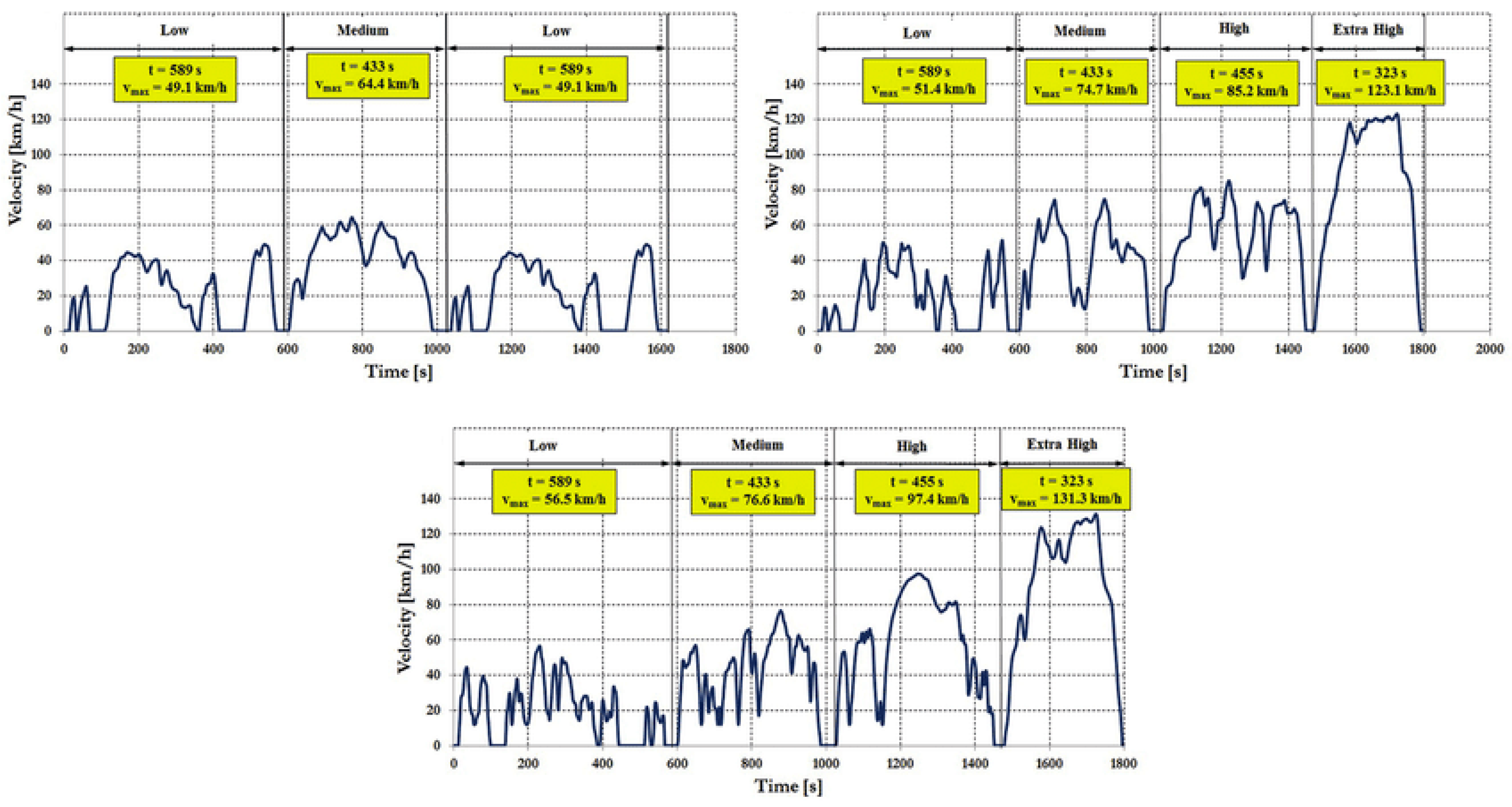Analysis of Fuel Cell Electric Vehicle Performance Under Standard Electric Vehicle Driving Protocol
Abstract
1. Introduction
2. Materials and Methods
2.1. Protocol Characteristics
- Class 1: Low-power vehicles (PWr < 22);
- Class 2: Medium-power vehicles (22 < PWr < 34);
- Class 3: High-power vehicles (PWr > 34).
2.2. Dynamic Analysis
3. Methodology
Fuel Cell Design
4. Results
Simulation of PEMFC Driving Range
- (a)
- Power source energy capacity: 99.53 kWh
| Protocol | NEDC | WLTP C3 | FTP-75 | JC08 |
|---|---|---|---|---|
| Driving Range (km) | 522.0 | 480.9 | 648.9 | 570.9 |
| Protocol | NEDC | WLTP C3 | FTP-75 | JC08 |
|---|---|---|---|---|
| Driving Range extension (km) | 18.8 | 16.6 | 20.5 | 19.5 |
| Driving Range increase (%) | 3.7 | 3.6 | 3.3 | 3.5 |
- (b)
- Power source energy capacity: 119.44 kWh
| Protocol | NEDC | WLTP C3 | FTP-75 | JC08 |
|---|---|---|---|---|
| Driving Range (km) | 624.4 | 575.2 | 776.7 | 683.2 |
| Protocol | NEDC | WLTP C3 | FTP-75 | JC08 |
|---|---|---|---|---|
| Driving Range extension (km) | 20.3 | 17.8 | 22.4 | 21.3 |
| Driving Range increase (%) | 3.4 | 3.2 | 3.0 | 3.2 |
5. Discussion
6. Conclusions
Author Contributions
Funding
Institutional Review Board Statement
Informed Consent Statement
Data Availability Statement
Conflicts of Interest
References
- International Energy Agency. World Energy Outlook 2023—Analysis—IEA. Available online: https://origin.iea.org/reports/world-energy-outlook-2023 (accessed on 20 March 2024).
- Winebrake, J.J.; Corbett, J.J.; Falzarano, A.; Hawker, J.S.; Korfmacher, K.; Ketha, S.; Zilora, S. Assessing Energy, Environmental, and Economic Tradeoffs in Intermodal Freight Transportation. J. Air Waste Manag. Assoc. 2008, 58, 1004–1013. [Google Scholar] [CrossRef] [PubMed]
- Use of Energy Explained. Energy Use for Transportation. Independent Statistics and Analysis. U.S. Energy Information Administration (EIA). Available online: https://www.eia.gov/energyexplained/use-of-energy/transportation.php#:~:text=About%2027%25%20of%20total%20U.S.%20energy%20consumption%20in,and%20goods%20from%20one%20place%20to%20another.%201 (accessed on 20 March 2024).
- Our World in Data. Sector by Sector: Where do Global Greenhouse Gas Emissions Come from?—Our World in Data. Available online: https://ourworldindata.org/ghg-emissions-by-sector (accessed on 20 March 2024).
- European Environment Agency. Greenhouse Gas Emissions from Transport in Europe. Available online: https://www.eea.europa.eu/en/analysis/indicators/greenhouse-gas-emissions-from-transport?activeAccordion= (accessed on 20 March 2024).
- Koubi, V. Sustainable development impacts of climate change and natural disaster. Backgr. Pap. Prep. Sustain. Dev. Outlook 2019, 1–55. [Google Scholar]
- Dey, R.; Lewis, S.C. Natural disasters linked to climate change. In The Impacts of Climate Change; Elsevier: Amsterdam, The Netherlands, 2021; pp. 177–193. [Google Scholar]
- Field, C.B. (Ed.) Managing the Risks of Extreme Events and Disasters to Advance Climate Change Adaptation: Special Report of the Intergovernmental Panel on Climate Change; Cambridge University Press: Cambridge, UK, 2012. [Google Scholar]
- United Nations Climate Change. What is the Kyoto Protocol? Process and Meetings. Available online: https://unfccc.int/process-and-meetings/the-kyoto-protocol (accessed on 20 March 2024).
- United Nations. Kyoto Protocol to the United Nations Framework. Convention on Climate Change. 1998. Available online: https://unfccc.int/resource/docs/convkp/kpeng.pdf (accessed on 20 March 2024).
- United Nations. The Paris Agreement. Climate Action. Available online: https://www.un.org/en/climatechange/paris-agreement (accessed on 20 March 2024).
- European Council. UN Climate Change Conference (COP 26), World Leaders Summit, Glasgow, UK, 1 November 2021. Available online: https://www.consilium.europa.eu/en/meetings/international-summit/2021/11/01/ (accessed on 20 March 2024).
- Briefing. International Council on Clean Transportation. Update on Government Targets for Phasing out New Sales of Internal Combustion Engine Passenger Cars. 2021. Available online: https://theicct.org/sites/default/files/publications/update-govt-targets-ice-phaseouts-jun2021_0.pdf (accessed on 20 March 2024).
- Burch, I.; Gilchrist, J. Survey of Global Activity to Phase Out Internal Combustion Engine Vehicles; Jancock, A., Waaland, G., Eds.; April 2020 Revision; The Climate Center: Santa Rosa, CA, USA, 2020; Available online: https://theclimatecenter.org/wp-content/uploads/2020/04/Survey-on-Global-Activities-to-Phase-Out-ICE-Vehicles-04.06.2020.pdf (accessed on 20 March 2024).
- Mantley, N. EU Member States Adopt ICE Sales Ban Almost Unanimously; Updated on 165 February 2024; Electrive: Berlin, Germany, 2024; Available online: https://www.electrive.com/2023/03/28/eu-member-states-adopt-ice-sales-ban-almost-unanimously/ (accessed on 20 March 2024).
- Li, S.; Zhu, X.; Ma, Y.; Zhang, F.; Zhou, H. The Role of Government in the Market for Electric Vehicles: Evidence from China. J. Policy Anal. Manag. 2022, 41, 450–485. [Google Scholar] [CrossRef]
- Yoo, S.; Park, S. South Korea’s national pursuit for fuel cell electric vehicle development: The role of government R&D programs over 30 years (1989–2021). Int. J. Hydrogen Energy 2023, 48, 9540–9550. [Google Scholar] [CrossRef]
- Haslam, G.E.; Jupesta, J.; Parayil, G. Assessing fuel cell vehicle innovation and the role of policy in Japan, Korea and China. Int. J. Hydrogen Energy 2012, 37, 14612–14623. [Google Scholar] [CrossRef]
- Jung, J.; Lee, D.-J.; Yoshida, K. Comparison between Korean and Japanese consumers’ preferences for fuel cell electric vehicles. Transp. Res. Part D Transp. Environ. 2022, 113, 103511. [Google Scholar] [CrossRef]
- Briefing. International Council on Clean Transportation. Annual Update on the Global Transition to Electric Vehicles: 2022. 2023. Available online: https://theicct.org/wp-content/uploads/2023/06/Global-EV-sales-2022_FINAL.pdf (accessed on 20 March 2024).
- Schmidt, S. Testing and Assessment Protocol. Release 2.0 Ecotest. ADAC Technik Zentrum. FIA Foundation for the Automobile and Society. Available online: https://olino.org/blog/nl/wp-content/uploads/2016/06/EcoTest-.pdf (accessed on 20 March 2024).
- New European Driving Cycle (NEDC). New European Driving Cycle—Wikipedia, la Enciclopedia Libre. Available online: https://es.wikipedia.org/wiki/New_European_Driving_Cycle (accessed on 20 March 2024).
- World Harmonized Light-Duty Vehicle Test Procedure (WLTP). Available online: https://en.wikipedia.org/wiki/Worldwide_Harmonised_Light_Vehicles_Test_Procedure (accessed on 20 March 2024).
- WLTPfacts.eu—Worldwide Harmonised Light Vehicle Test Procedure. Available online: https://www.wltpfacts.eu/ (accessed on 20 March 2024).
- FTP-75. Emission Test Cycles. DieselNet. Available online: https://dieselnet.com/standards/cycles/ftp75.php (accessed on 20 March 2024).
- FTP-75. Available online: https://en.wikipedia.org/wiki/FTP-75 (accessed on 20 March 2024).
- Japanese JC08 Cycle. Japanese JC08 Cycle. DieselNet. Available online: https://dieselnet.com/standards/cycles/jp_jc08.php (accessed on 20 March 2024).
- Japan Inspection Organization. Japanese JC08 Emission Test Cycle. Available online: https://japaninspection.org/japanese-jc08-emission-test-cycle/ (accessed on 20 March 2024).
- Depcik, C.; Cassady, T.; Collicott, B.; Burugupally, S.P.; Li, X.; Alam, S.S.; Arandia, J.R.; Hobeck, J. Comparison of lithium ion Batteries, hydrogen fueled combustion Engines, and a hydrogen fuel cell in powering a small Unmanned Aerial Vehicle. Energy Convers. Manag. 2020, 207, 112514. [Google Scholar] [CrossRef]
- Le Duigou, A.; Smatti, A. On the comparison and the complementarity of batteries and fuel cells for electric driving. Int. J. Hydrogen Energy 2014, 39, 17873–17883. [Google Scholar] [CrossRef]
- Winter, M.; Brodd, R.J. What are batteries, fuel cells, and supercapacitors? Chem. Rev. 2004, 104, 4245–4270. [Google Scholar] [CrossRef] [PubMed]
- Thomas, C.E. Fuel cell and battery electric vehicles compared. Int. J. Hydrogen Energy 2009, 34, 6005–6020. [Google Scholar] [CrossRef]
- Muthukumar, M.; Rengarajan, N.; Velliyangiri, B.; Omprakas, M.; Rohit, C.; Raja, U.K. The development of fuel cell electric vehicles—A review. Mater. Today Proc. 2021, 45, 1181–1187. [Google Scholar] [CrossRef]
- Thomas, C.E.; James, B.D.; Lomax, F.D., Jr.; Kuhn, I.F., Jr. Fuel options for the fuel cell vehicle: Hydrogen, methanol or gasoline? Int. J. Hydrogen Energy 2000, 25, 551–567. [Google Scholar] [CrossRef]
- Das, H.S.; Tan, C.W.; Yatim, A.H.M. Fuel cell hybrid electric vehicles: A review on power conditioning units and topologies. Renew. Sustain. Energy Rev. 2017, 76, 268–291. [Google Scholar] [CrossRef]
- Pramuanjaroenkij, A.; Kakaç, S. The fuel cell electric vehicles: The highlight review. Int. J. Hydrogen Energy 2023, 48, 9401–9425. [Google Scholar] [CrossRef]
- Merkisz, J.; Lijewski, P.; Fuć, P.; Rymaniak, Ł.; Ziółkowski, A. Measurement of Exhaust Emissions under Actual Operating Conditions with the Use of PEMS: Review of Selected Vehicles; IntechOpen: London, UK, 2018. [Google Scholar]
- Toyota bZ4X Advance 200E 4x2 (2023)|Precio y Ficha Técnica-km77.com. Available online: https://www.km77.com/coches/toyota/bz4x/2023/estandar/estandar/bz4x-advance-4x2/datos (accessed on 21 March 2024).
- Hydrogen. Science & Tech. Britannica. Available online: https://www.britannica.com/science/hydrogen (accessed on 21 March 2024).
- Sepa Todo Acerca del Tamaño del Tanque de Gasolina de su Automóvil. Autofiles.com. Available online: https://autofiles.com/es/gas-tank-size/?utm_content=cmp-true (accessed on 21 March 2024).
- He, K.; Zhang, C.; He, Q.; Wu, Q.; Jackson, L.; Mao, L. Effectiveness of PEMFC historical state and operating mode in PEMFC prognosis. Int. J. Hydrogen Energy 2020, 45, 32355–32366. [Google Scholar] [CrossRef]
- Adegnon, K.M.; Dube, Y.; Agbossou, K. Experimental evaluation of PEM fuel cell systems efficiency. In Proceedings of the 2009 Canadian Conference on Electrical and Computer Engineering, St. John’s, NL, Canada, 3–6 May 2009; pp. 716–719. [Google Scholar]
- SynerHy Hydrogen Experts. Fuel Cell versus Battery. Available online: https://synerhy.com/2022/03/pila-de-combustible-vs-baterias-como-se-descarbonizaran-las-flotas-de-camiones/ (accessed on 21 March 2024).
- Available online: https://hyfindr.com/en/hydrogen-knowledge/hydrogen-tank (accessed on 21 March 2024).





| Electrolyte | Solid Polymeric Membrane |
|---|---|
| Operational temperature range (°C) | 50–100 |
| Charge carrier | Proton (H+) |
| Power range (kW) | 1–100 |
| Advantages | Quick start Low operational temperature Low corrosion Low maintenance Light Low size |
| Disadvantages | Expensive catalyzer Sensitive to hydrogen impurities |
| Efficiency (%) | 40–60 |
| Application sector | Transportation Residential use |
| NEDC | WLTP Class 1 | WLTP Class 2 | WLTP Class 3 | FTP-75 | JC08 | |
|---|---|---|---|---|---|---|
| Time (s) | 1180 | 1611 | 1800 | 1800 | 1877 | 1204 |
| Distance (km) | 11 | 11.43 | 22.65 | 23.27 | 17.7 | 8.17 |
| Max. speed (km/h) | 120 | 64.4 | 123.1 | 131.3 | 91.2 | 81.6 |
| Average speed (km/h) | 33.6 | 26.8 | 50.4 | 51.8 | 33.8 | 24.4 |
| Max. acceleration (m/s2) | 1 | 0.76 | 0.96 | 1.58 | 1.57 | 1.56 |
| Fuel | LHV (MJ/kg) | HHV (MJ/kg) | LHV (MJ/m3) | HHV (MJ/m3) | Ignition Energy (MJ) | Self-Ignition Point (°C) | Boling Point (°C) | Freezing Point (°C) |
|---|---|---|---|---|---|---|---|---|
| H2 | 119.9 | 141.6 | 10.8 | 12.7 | 0.017 | 585 | −252 | −260 |
| Protocol | NEDC | WLTP C3 | FTP-75 | JC08 |
|---|---|---|---|---|
| Cycle distance (km) | 11.0 | 23.25 | 17.77 | 8.0 |
| Protocol | NEDC | WLTP C3 | FTP-75 | JC08 |
|---|---|---|---|---|
| Fuel Cell | 46.645 | 22.069 | 28.875 | 64.138 |
| Battery | 45.745 | 21.643 | 28.317 | 62.900 |
| Protocol | NEDC | WLTP C3 | FTP-75 | JC08 |
|---|---|---|---|---|
| Driving Range (km) | 513.1 | 472.0 | 640.0 | 562.0 |
| Protocol | NEDC | WLTP C3 | FTP-75 | JC08 |
|---|---|---|---|---|
| Driving Range (km) | 503.2 | 464.3 | 628.4 | 551.4 |
| Protocol | NEDC | WLTP C3 | FTP-75 | JC08 |
|---|---|---|---|---|
| Driving Range extension (km) | 9.8 | 7.7 | 11.6 | 10.6 |
| Driving Range increase (%) | 2.0 | 1.7 | 1.9 | 1.9 |
| Protocol | NEDC | WLTP C3 | FTP-75 | JC08 |
|---|---|---|---|---|
| Driving Range (km) | 615.7 | 566.4 | 768.0 | 674.4 |
| Protocol | NEDC | WLTP C3 | FTP-75 | JC08 |
|---|---|---|---|---|
| Driving Range (km) | 604.1 | 557.4 | 754.3 | 661.9 |
| Protocol | NEDC | WLTP C3 | FTP-75 | JC08 |
|---|---|---|---|---|
| Driving Range extension (km) | 11.6 | 9.0 | 13.7 | 12.5 |
| Driving Range increase (%) | 1.9 | 1.6 | 1.8 | 1.9 |
Disclaimer/Publisher’s Note: The statements, opinions and data contained in all publications are solely those of the individual author(s) and contributor(s) and not of MDPI and/or the editor(s). MDPI and/or the editor(s) disclaim responsibility for any injury to people or property resulting from any ideas, methods, instructions or products referred to in the content. |
© 2025 by the authors. Licensee MDPI, Basel, Switzerland. This article is an open access article distributed under the terms and conditions of the Creative Commons Attribution (CC BY) license (https://creativecommons.org/licenses/by/4.0/).
Share and Cite
Armenta-Déu, C.; del Olmo, V. Analysis of Fuel Cell Electric Vehicle Performance Under Standard Electric Vehicle Driving Protocol. Future Transp. 2025, 5, 158. https://doi.org/10.3390/futuretransp5040158
Armenta-Déu C, del Olmo V. Analysis of Fuel Cell Electric Vehicle Performance Under Standard Electric Vehicle Driving Protocol. Future Transportation. 2025; 5(4):158. https://doi.org/10.3390/futuretransp5040158
Chicago/Turabian StyleArmenta-Déu, Carlos, and Víctor del Olmo. 2025. "Analysis of Fuel Cell Electric Vehicle Performance Under Standard Electric Vehicle Driving Protocol" Future Transportation 5, no. 4: 158. https://doi.org/10.3390/futuretransp5040158
APA StyleArmenta-Déu, C., & del Olmo, V. (2025). Analysis of Fuel Cell Electric Vehicle Performance Under Standard Electric Vehicle Driving Protocol. Future Transportation, 5(4), 158. https://doi.org/10.3390/futuretransp5040158






